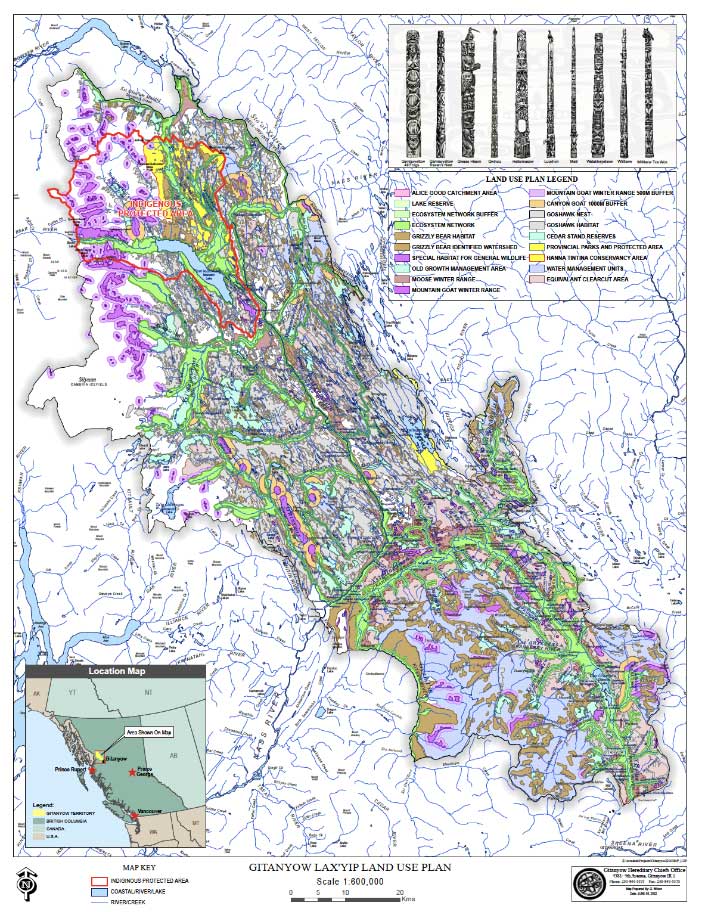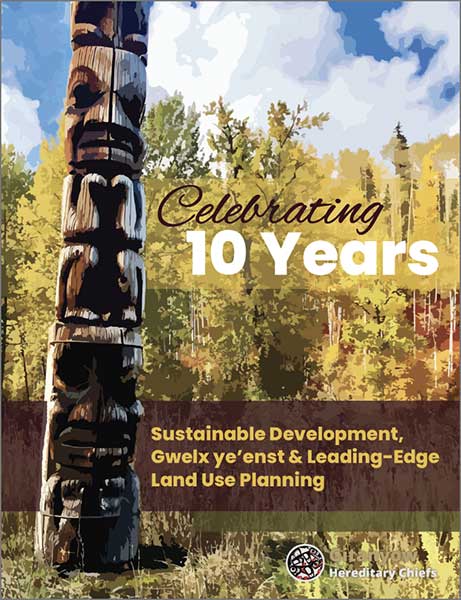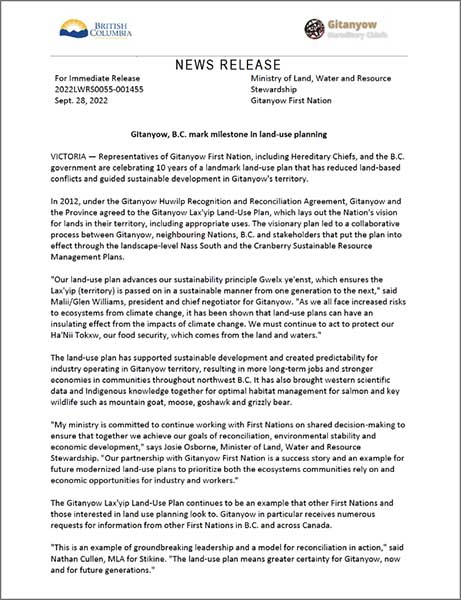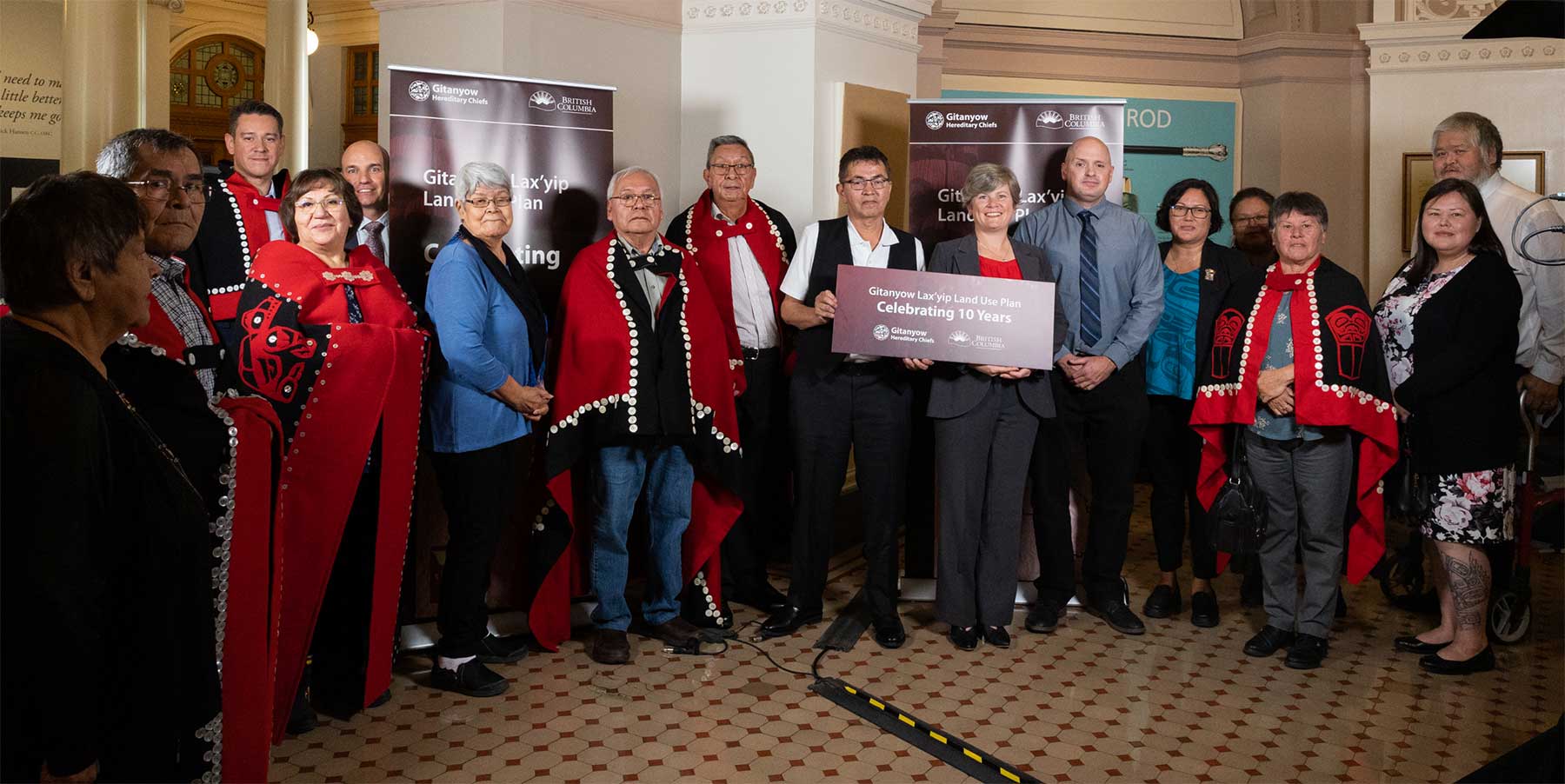Gitanyow Lax’yip Land Use Plan

a landscape level plan
The Gitanyow Lax’yip Land Use Plan (GLLUP) was negotiated between the Gitanyow Hereditary Chiefs and the provincial government of British Columbia over 10 years, culminating in 2012 with the Gitanyow Huwilp Recognition & Reconciliation Agreement. The government-to-government commitment to the GLLUP has been reaffirmed in subsequent renewals of the Recognition & Reconciliation Agreement in 2016 and 2021.
The GLLUP is a landscape level plan that covers the entire Gitanyow Lax’yip, and overlaps 3 administrative planning boundaries for the provincial government, and 3 Timber Supply Areas. The plan is an expression of Gitanyow Aboriginal rights and title, specifically the right to choose how the land is used, and by whom. Aboriginal rights and title are protected under the Canadian Constitution Act, 1982. Further, the right to land, self-determination, and free, prior and informed consent are enshrined in the United Nations Declaration on the Rights of Indigenous Peoples.
The GLLUP applies to ALL proposed activities or development in the Lax’yip, and includes multiple management zones to protect Gitanyow cultural values including:
Ecosystem Networks and Buffers En sii wineex
a landscape level plan
The Gitanyow Lax’yip Land Use Plan (GLLUP) was negotiated between the Gitanyow Hereditary Chiefs and the provincial government of British Columbia over 10 years, culminating in 2012 with the Gitanyow Huwilp Recognition & Reconciliation Agreement. The government-to-government commitment to the GLLUP has been reaffirmed in subsequent renewals of the Recognition & Reconciliation Agreement in 2016 and 2021.
The GLLUP is a landscape level plan that covers the entire Gitanyow Lax’yip, and overlaps 3 administrative planning boundaries for the provincial government, and 3 Timber Supply Areas. The plan is an expression of Gitanyow Aboriginal rights and title, specifically the right to choose how the land is used, and by whom. Aboriginal rights and title are protected under the Canadian Constitution Act, 1982. Further, the right to land, self-determination, and free, prior and informed consent are enshrined in the United Nations Declaration on the Rights of Indigenous Peoples.
The GLLUP applies to ALL proposed activities or development in the Lax’yip, and includes multiple management zones to protect Gitanyow cultural values including:
Ecosystem Networks and Buffers En sii wineex
Water Management Units En’hluik Sim’aks
Gitanyow Cultural Site En’sii wil jokxw
Moose Winter Range Xa’daa
Cedar Reserces Ama’tel
Grizzly Bear Habitat En’jokhl’liki’insxw
Mountain Goat Winter Range En jokhl’metx
Pine Mushroom Habitat Gayt’m ts’uuts’



Celebrating 10 Years
In 2022, the Gitanyow Hereditary Chiefs and the provincial government of British Columbia celebrated the 10th Anniversary of the Gitanyow Lax’yip Land Use Plan. The Anniversary was commemorated with a small celebration at the Legislative Assembly in Victoria, BC with Ministers Josie Osborne and Nathan Cullen, the Gitanyow Hereditary Chiefs, media, and many allies and supporters including representatives from the forest industry.




Celebrating 10 Years
In 2022, the Gitanyow Hereditary Chiefs and the provincial government of British Columbia celebrated the 10th Anniversary of the Gitanyow Lax’yip Land Use Plan. The Anniversary was commemorated with a small celebration at the Legislative Assembly in Victoria, BC with Ministers Josie Osborne and Nathan Cullen, the Gitanyow Hereditary Chiefs, media, and many allies and supporters including representatives from the forest industry.






How to Apply the GLLUP in Proposed Development on the Lax’yip
1. Download Shapefiles for the GLLUP
2. Assess proposed activities in accordance with the mapped zonations in the Shapefiles
3. Refer to the GLLUP text for affected Zones for Management Direction, Targets, and Guidance for specific Zones.
4. Complete Early Engagement Record with required information and submit via email.
5. Confirm proposed activity is reviewable under the Gitanyow Wilp Sustainability Assessment Process
It is strongly recommended that proponents do NOT invest significant resources, time or capital into development proposals prior to discussing the project concept with Gitanyow, including the potential affected Wilp. It is also strongly recommended that assessing the nature of the development in accordance with the GLLUP is done as early as possible, and that projects that pose significant risk of violation of the GLLUP are not advanced.